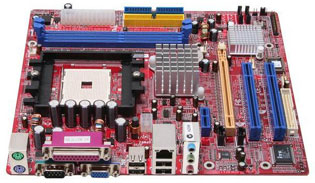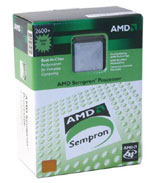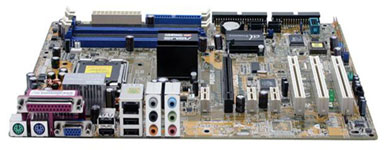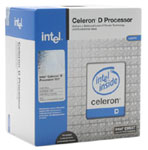Entry Level Buyer's Guide, October 2005
by Jarred Walton on October 14, 2005 12:05 AM EST- Posted in
- Guides
Office CPU and Motherboard Recommendations
We've wavered back and forth between choosing integrated graphics vs. discrete graphics for the budget systems. Outside of gaming, though, there isn't really a need for even a low-end graphics card. The woefully inadequate - at least for games - Intel Extreme Graphics 2 in the 865G chipset is still perfectly good for office work. Newer options like the 915G's GMA900 and the 945G's GMA950 are quite a bit faster than the 865G, but they're still slower than almost any add-in card. We also have IGP options from both NVIDIA and ATI now, rounding out the possibilities.
What about Windows Vista, right? If Vista ships and you find that your IGP can't meet the demands, the solution is simple: buy a graphics card at that point in time. The $50 budget cards of late 2006 will be far more powerful than the $50 cards that are currently available. The only thing that you need to do is to make sure that your motherboard has an add-in graphics port, preferably PCIe X16. Our recommendations will meet that requirement. We'll start with the AMD choices.
AMD Office Motherboard: Biostar GeForce 6100-M7
Price: $66 shipped
AMD Office CPU: Sempron 64 (754) 2600+ - 128KB, 1.60 GHz Palermo
Price: $63 shipped (Retail)
Total: $129
We covered the launch of the NVIDIA 6100 chipset recently, and we've even done a follow-up with some BIOS updates for the ATI board. The end result is that performance is relatively close between the two contenders, so the purchase decision really depends on price. Biostar makes the only currently shipping 6100 board, while there are a few shipping Xpress 200 boards. However, only one socket 754 Xpress 200 board is available, and since we'd just as soon not spend an extra $50 on the processor, our choice is narrowed to the MSI RS480M-IL 754 or the Biostar GeForce 6100-M7. $91 vs. $65 makes the decision a no-brainer.
Athlon 64 for socket 754 represents a much faster solution, but it carries a higher cost as well. We took a look at all the shipping socket 754 processors that include 64-bit support - why get a regular Sempron when the 64-bit enabled versions typically cost less than a dollar more, right? The Sempron 2500+ starts at $63, as does the 2600+. Do you want 1.40 GHz with 256K of cache or 1.60 GHz with 128K of cache? Or do you spend the extra $11 to get both with the Sempron 2800+? Perhaps another $10 to drop back to 128K cache, but increase the CPU speed to 1.80 GHz, courtesy of the 3000+, would be best? Beyond the 3000+, prices jump $20 for the 3100+. OEM versions are $10 cheaper, but since a heat sink and fan will cost that much, there's little reason to pick up such a chip. (OEM chips from AMD are going to disappear soon, if that concerns you.) If your budget is really tight, though, the Sempron 2600+ packs the most bang for the buck.
We're going to downgrade performance as well as lower the price relative to the last Budget Guide, and save the slightly faster picks for the gaming configurations. Compared to our mid-range picks from last month, you're getting the CPU as well as the motherboard for less than the cost of just the CPU. Sure, it's a slower system overall, but it's still plenty fast for most computer needs. If you're doing something that requires more processing power, we're doubtful that you'd even consider a budget system.
If you really want a faster CPU, Athlon 64 chips are a good buy, but we'd suggest moving to socket 939 if you can manage to spend the extra money. Overclockers looking for bang-for-the-buck could try out the Turion chips, but at current prices, you would be far better off with socket 939 and Venice cores. Sempron Palermo parts like the 3000+ and 3100+ work pretty well at speeds up to 2.5 GHz, but the reduced cache of the 3100+ will just about equal a 2.2 GHz 512K Athlon 64. For overclocking on the cheap, you can save around $100 relative to a non-overclocked 939 system. (Did we just use "cheap" and "overclocking" in the same sentence? Yeah, it's probably asking for too much - move along, nothing to see here...)
Intel Office Motherboard: ASUS P5RD1-V
Price: $91 shipped
Intel Office CPU: Celeron D 331 - 256KB, 2.66 GHz Prescott
Price: $79 shipped (Retail)
Total: $170
Intel platform motherboards are almost always more expensive, and that's the case here. There is as yet no NVIDIA competitor for socket 775, so our IGP choices are limited to ATI's Xpress 200 or Intel's 915G and 945G. The 915G and Xpress 200 both lack support for Pentium D chips, but the likelihood of upgrading to such a processor during the life of the computer is small. 945G costs about $10 more than 915G - you'll want to avoid the GL and GV versions of the chipsets if you want dual-channel RAM support. Since 915G is at EOL (End of Life), we narrowed the final choice down to the 945G and Xpress 200, and opted to go with the latter for the improved IGP. If you really don't care about graphics performance at all, the 945G has slightly better overall performance. In either case, you can always add a faster discrete card in the future.
There are at present two Xpress 200 socket 775 boards on the market. One is from ECS and the other is from ASUS, and while the ECS board is $20 cheaper, it also comes with two DDR and two DDR2 slots. DDR2 is no more expensive than DDR these days, but since you can't use both in the ECS board, you end up with two usable DIMM slots. Even for a budget system, we would much rather have the potential to add more RAM, so we went for the ASUS with its four DDR slots. The word on the street is that, unlike the early AMD Xpress 200 boards, the ASUS board for socket 775 can actually overclock decently. Most budget shoppers probably won't care one way or the other, of course.
The CPU prices on Intel bottom out around $75, where AMD CPUs can go for as little as $60. We looked at all the Intel processors and found that the best choice was the Celeron D 331. The 331 is a newer version of the 330 chip with enabled EM64T support. Budget computing and 64-bit power seems a bit of a mismatch right now, but if you plan on keeping the computer for three or four years, 64-bit support might become important. Performance, as with the Sempron selection, should be adequate for most business and home user tasks. Even light gaming will work well, provided the IGP is sufficient - integrated graphics will be the bottleneck for just about any game anyway.
We've wavered back and forth between choosing integrated graphics vs. discrete graphics for the budget systems. Outside of gaming, though, there isn't really a need for even a low-end graphics card. The woefully inadequate - at least for games - Intel Extreme Graphics 2 in the 865G chipset is still perfectly good for office work. Newer options like the 915G's GMA900 and the 945G's GMA950 are quite a bit faster than the 865G, but they're still slower than almost any add-in card. We also have IGP options from both NVIDIA and ATI now, rounding out the possibilities.
What about Windows Vista, right? If Vista ships and you find that your IGP can't meet the demands, the solution is simple: buy a graphics card at that point in time. The $50 budget cards of late 2006 will be far more powerful than the $50 cards that are currently available. The only thing that you need to do is to make sure that your motherboard has an add-in graphics port, preferably PCIe X16. Our recommendations will meet that requirement. We'll start with the AMD choices.
 |
 |
| Click images to enlarge. | |
AMD Office Motherboard: Biostar GeForce 6100-M7
Price: $66 shipped
AMD Office CPU: Sempron 64 (754) 2600+ - 128KB, 1.60 GHz Palermo
Price: $63 shipped (Retail)
Total: $129
We covered the launch of the NVIDIA 6100 chipset recently, and we've even done a follow-up with some BIOS updates for the ATI board. The end result is that performance is relatively close between the two contenders, so the purchase decision really depends on price. Biostar makes the only currently shipping 6100 board, while there are a few shipping Xpress 200 boards. However, only one socket 754 Xpress 200 board is available, and since we'd just as soon not spend an extra $50 on the processor, our choice is narrowed to the MSI RS480M-IL 754 or the Biostar GeForce 6100-M7. $91 vs. $65 makes the decision a no-brainer.
Athlon 64 for socket 754 represents a much faster solution, but it carries a higher cost as well. We took a look at all the shipping socket 754 processors that include 64-bit support - why get a regular Sempron when the 64-bit enabled versions typically cost less than a dollar more, right? The Sempron 2500+ starts at $63, as does the 2600+. Do you want 1.40 GHz with 256K of cache or 1.60 GHz with 128K of cache? Or do you spend the extra $11 to get both with the Sempron 2800+? Perhaps another $10 to drop back to 128K cache, but increase the CPU speed to 1.80 GHz, courtesy of the 3000+, would be best? Beyond the 3000+, prices jump $20 for the 3100+. OEM versions are $10 cheaper, but since a heat sink and fan will cost that much, there's little reason to pick up such a chip. (OEM chips from AMD are going to disappear soon, if that concerns you.) If your budget is really tight, though, the Sempron 2600+ packs the most bang for the buck.
We're going to downgrade performance as well as lower the price relative to the last Budget Guide, and save the slightly faster picks for the gaming configurations. Compared to our mid-range picks from last month, you're getting the CPU as well as the motherboard for less than the cost of just the CPU. Sure, it's a slower system overall, but it's still plenty fast for most computer needs. If you're doing something that requires more processing power, we're doubtful that you'd even consider a budget system.
If you really want a faster CPU, Athlon 64 chips are a good buy, but we'd suggest moving to socket 939 if you can manage to spend the extra money. Overclockers looking for bang-for-the-buck could try out the Turion chips, but at current prices, you would be far better off with socket 939 and Venice cores. Sempron Palermo parts like the 3000+ and 3100+ work pretty well at speeds up to 2.5 GHz, but the reduced cache of the 3100+ will just about equal a 2.2 GHz 512K Athlon 64. For overclocking on the cheap, you can save around $100 relative to a non-overclocked 939 system. (Did we just use "cheap" and "overclocking" in the same sentence? Yeah, it's probably asking for too much - move along, nothing to see here...)
 |
 |
| Click images to enlarge. | |
Intel Office Motherboard: ASUS P5RD1-V
Price: $91 shipped
Intel Office CPU: Celeron D 331 - 256KB, 2.66 GHz Prescott
Price: $79 shipped (Retail)
Total: $170
Intel platform motherboards are almost always more expensive, and that's the case here. There is as yet no NVIDIA competitor for socket 775, so our IGP choices are limited to ATI's Xpress 200 or Intel's 915G and 945G. The 915G and Xpress 200 both lack support for Pentium D chips, but the likelihood of upgrading to such a processor during the life of the computer is small. 945G costs about $10 more than 915G - you'll want to avoid the GL and GV versions of the chipsets if you want dual-channel RAM support. Since 915G is at EOL (End of Life), we narrowed the final choice down to the 945G and Xpress 200, and opted to go with the latter for the improved IGP. If you really don't care about graphics performance at all, the 945G has slightly better overall performance. In either case, you can always add a faster discrete card in the future.
There are at present two Xpress 200 socket 775 boards on the market. One is from ECS and the other is from ASUS, and while the ECS board is $20 cheaper, it also comes with two DDR and two DDR2 slots. DDR2 is no more expensive than DDR these days, but since you can't use both in the ECS board, you end up with two usable DIMM slots. Even for a budget system, we would much rather have the potential to add more RAM, so we went for the ASUS with its four DDR slots. The word on the street is that, unlike the early AMD Xpress 200 boards, the ASUS board for socket 775 can actually overclock decently. Most budget shoppers probably won't care one way or the other, of course.
The CPU prices on Intel bottom out around $75, where AMD CPUs can go for as little as $60. We looked at all the Intel processors and found that the best choice was the Celeron D 331. The 331 is a newer version of the 330 chip with enabled EM64T support. Budget computing and 64-bit power seems a bit of a mismatch right now, but if you plan on keeping the computer for three or four years, 64-bit support might become important. Performance, as with the Sempron selection, should be adequate for most business and home user tasks. Even light gaming will work well, provided the IGP is sufficient - integrated graphics will be the bottleneck for just about any game anyway.










35 Comments
View All Comments
Rocket321 - Friday, October 14, 2005 - link
Is 100 hours an exaggeration or near the true testing time for that type of article? I guess that would leave lots of time to write an article to go with the numbers.Just curious.
Rocket321
JarredWalton - Friday, October 14, 2005 - link
Read the http://www.anandtech.com/cpuchipsets/showdoc.aspx?...">Venice overclocking article. 100 hours isn't really an exaggeration, if I'm thorough. It's about 5 hours per complete benchmark run, assuming it doesn't crash or fail at some point. (Or just get stuck - WinStones can do that, even on a stable system. It just sits at some point where the script got stuck, and you have to manually restart it. That sucks when you start the benchmark, leave, and come back five hours later to find that it only ran for 5 minutes before getting stuck.)So, 1.8 GHz to 2.6 GHz is five configurations, and two RAM choices makes for 10 benchmark runs. Given the amount of time there are glitches to address, 100 hours is probably about right. Luckily, I don't have to be sitting at the PC the whole time. Heheh.
mino - Friday, October 14, 2005 - link
Well, as usuall. Someone clearly stole some letters here and there. I apologize for him :)just one addon:
This guide IS one of the best(if not the best) one could find around. No irony here.
I felt my comment was not clear enough on that matter.
yacoub - Friday, October 14, 2005 - link
http://forums.anandtech.com/messageview.aspx?catid...">http://forums.anandtech.com/messageview...amp;thre...noxipoo - Friday, October 14, 2005 - link
while it is a good guide for the price, I think the price targets needs to be revised or followed better. it is the same issue I had with the mid-range system guide. 1200-1500 is just not mid-range for me. kind of feels like the guy that told me 55 grand for a car is mid-range because there are ferraris that cost a lot more...JarredWalton - Friday, October 14, 2005 - link
A few quotes from the summary page:"You might not realize this, but I actually pick the parts that I want to include and only then tally the cost. As long as I'm within about $100, I usually stick with it - if I overshoot the budget, it's because I really don't feel that it's a good idea to cut corners any further just to shave $50 from the total."
That should explain my philosophy. Others disagree with it, but if you can spend $500, you can also spend $600. This budget guide is cheaper (for the non-gaming setups especially) then the last one. I also offered advice on how to cut costs of either system:
"If the $500 price point is really important, dropping to 512MB of RAM and getting rid of the speakers will get you close."
As well as:
"Our gaming configurations exceed the target $750 price by a bit more, though there are additional opportunities for cutting costs. Getting the less expensive options on the RAM, HDD, DVDR, display, and speakers will cut the price of each system by $90 without really affecting performance or features much (other than the noticeable change in display size)."
The tables are quick summaries of 7000+ words of text, and as such they cannot even begin to convey all of the options that are out there. That's what all the extra writing is for, to explain why the final choices were made.
And of course, for every person like you who feels the price is too high, there are several others suggesting upgrades like a better PSU, an LCD, a different case, etc. Catch-22. If you can actually put together a complete PC for $500 that people on here would really consider better, I'd be more than surprised. Feel free to post such a system, though, and ask for comments from others. :)
PrinceGaz - Friday, October 14, 2005 - link
I don't think dropping down from 2x512MB of RAM to 1x512MB of RAM would be a good idea on the AMD gaming system, despite it being a S754 CPU with asingle-channel memory, as it would only save $48 at the prices listed. Many games these days require a minimum of 512MB to run acceptably, and having 1GB makes a big difference with many. And then there's BF2 which likes more than 1GB, and others will follow soon.Rather than drop down from 1GB to 512MB and cause stuttering in the latest demanding games, you'd be better off saving a similar amount of money by getting a cheaper graphics-card like a standard 6600, or an X700Pro. Let's face it, the sort of games that need more than a 6600 or X700Pro, are also going to need more than 512MB of system memory to run smoothly, so the money is better spent on double the memory rather than a faster graphics-card.
Apart from that, a good article. Putting together systems on a tiny budget isn't easy as you're always having to weigh the consequences of shifting a few dollars from one area to another.
JarredWalton - Friday, October 14, 2005 - link
Actually, the 512MB RAM comment was for the office systems. For the gaming, I'd just go with the cheaper options (listed in the office configs) for every part, other than the GPU. $95 RAM vs. $87 RAM, $169 CRT vs. $127, etc.Adding up the total cost of the "value gaming", you could get:
AMD:
Sempron 64 (754) 3000+ - 128KB 1.80 GHz Palermo 75
DFI Infinity nF4X 77
Patriot Signature CL2.5 2x512MB 87
eVGA GeForce 6600GT 128MB 138
Hitachi 3.0Gbps 80GB 7200RPM 8MB Deskstar 7K80 57
NEC 3540A Black (OEM) 41
Foxconn 3GTH-002 plus 300W PSU 70
Envision EFT720 17" CRT 127
Logitech X-230 2.1 Speakers 37
Logitech Internet Pro Desktop 23
Bottom Line $732
Intel:
Celeron D 331 - 256KB 2.66 GHz Prescott 79
Gigabyte GA-8I945P-G 113
Patriot Signature PC-4200 2x512MB 74
eVGA GeForce 6600GT 128MB 138
Hitachi 3.0Gbps 80GB 7200RPM 8MB Deskstar 7K80 57
NEC 3540A Black (OEM) 41
Foxconn 3GTH-002 plus 300W PSU 70
Envision EFT720 17" CRT 127
Logitech X-230 2.1 Speakers 37
Logitech Internet Pro Desktop 23
Bottom Line $759
The display is still a big compromise, IMO, but everything else on that alternative gaming setup is almost as good as the higher cost version. I still prefer to spend the extra, particularly on the case/PSU, speakers, CRT, and HDD. The RAM and the DVDR upgrades are less critical.
RandomFool - Friday, October 14, 2005 - link
Not to nit pick but if you're going to make a budget system and set a target price of 750 you really shouldn't go over that by more than 20-30 bucks. I realize gaming systems need more oomph but it is a budget system. You could cut back on ram grab some normal 2.1 speakers (i don't think 5.1 is required at all.) and be alot close to 750 before OS that is.Also the price of an OS should be included because without one all you have is a box that wasted electricity.
flatblastard - Friday, October 14, 2005 - link
I couldn't agree with you more. The trend here lately seems to be to blow the budget by $100 or more. The rigs in my newegg wishlist would probably have made better candidates for the entry-level and mid-range price guides of late, and they don't cost more than the budget I originally set for them either.